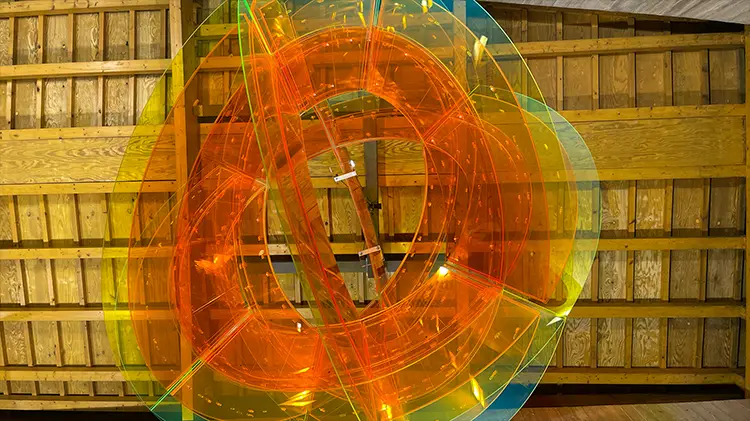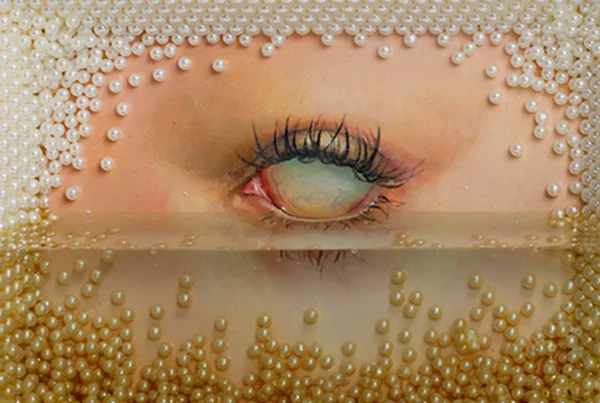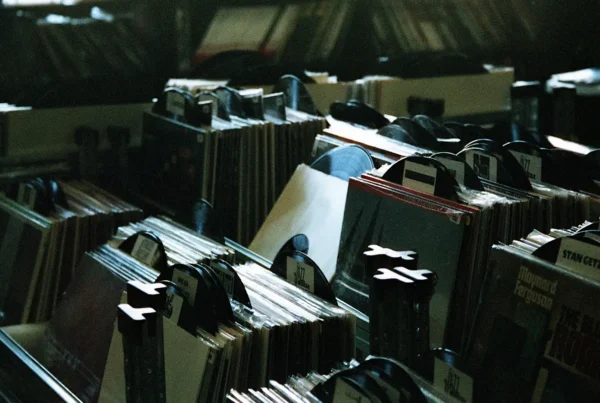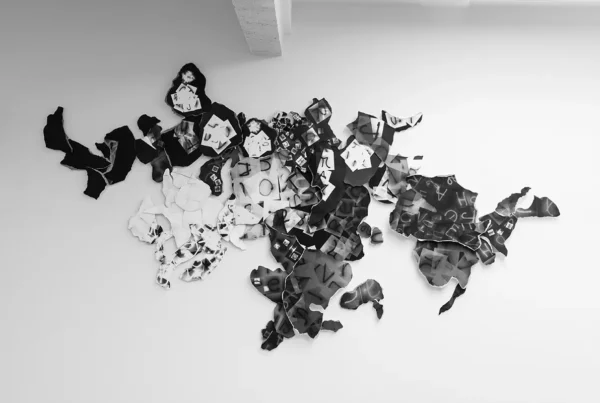“I try to approach every project with an open mind, with no pre-thoughts.”
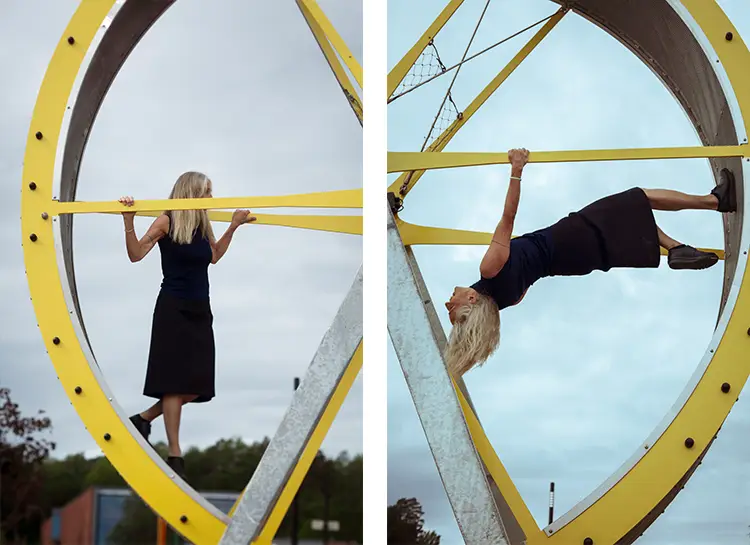
Yellow Enigma, 2024.
Sculpture, galvanized and painted steel. 500 x 450 x 160 cm.
All photos: Marie Sjøvold, curtesy of Asker municipality Art Collection.
Situating the Public: From Site-Specificity to Infrastructural Relationality
Viel Bjerkeset Andersen’s decades-long practice reorients the traditional notion of public art from visual adornment toward the orchestration of encounters within infrastructural environments. Her works challenge passive spectatorship by embedding themselves within systems of transit, education, and care, contexts where the public is not optional and where art must perform within institutional and logistical constraints. The theoretical backdrop for interpreting her practice must therefore extend beyond object-based aesthetics to consider what Claire Bishop calls the “social turn” in art, with its demand for critical reflection on participation, exclusion, and power. Andersen’s art does not merely activate space; it produces a sustained grammar of co-presence through architectural materiality, ambient modulation, and participatory ambiguity.
Her works embody what Miwon Kwon terms an “itinerary” model of site-specificity. They are less about fixed spatial identity and more about navigating networks of institutional, social, and ecological relations. Projects such as Behind the Breath or Stopover do not function as autonomous artworks. They exist as performative nodes within operational systems—transport infrastructure, educational spaces, urban planning frameworks—where meaning, function, and relevance unfold incrementally through time. This infrastructural orientation allows Andersen to avoid the didactic traps of public art while also resisting the abstraction and placelessness of minimalist design. Her attention to light, for instance, is never merely visual; it indexes psychological states, seasonal rhythms, and ecological implications, offering what Nicolas Bourriaud described as “interstices” for social interaction but adjusted to audiences that do not opt in voluntarily.
What emerges is a distinct theory-in-practice: a form of relational public art rooted not in the convivial event-making of early relational aesthetics but in the sustained modulation of shared environments. Where those earlier practices often relied on voluntary participation and ephemeral hospitality, Andersen’s works operate within frameworks of permanence, maintenance, and institutional governance. They ask not only who participates and how, but also who funds, who stewards, and who repairs. These are questions that, as Bishop insists, must be central to any ethics of relation. The public is not a homogenous body; it is a stratified, plural field of users, workers, observers, and bystanders. Andersen’s interventions reflect this complexity by avoiding overt instruction and instead fostering slow, material resonance over time.
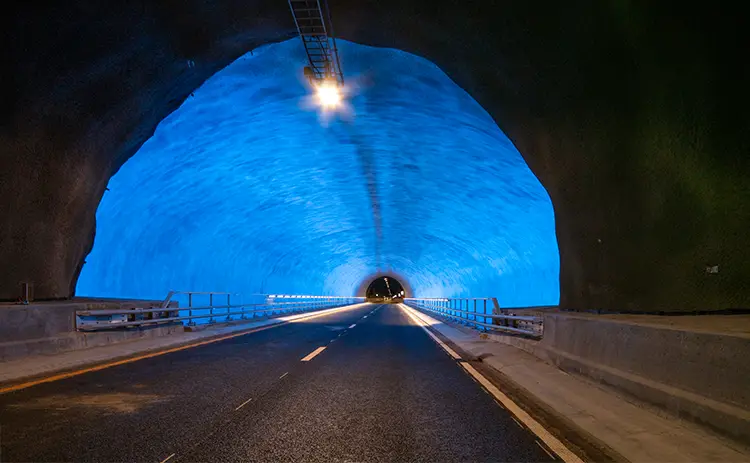
Behind the Breath, 2019.
Two drop shaped rock rooms, programmed LED-light. Length 125 meters, hight 12 meters, at the widest 30 meters.
Photo: Viel Bjerkeset Andersen, curtesy of the Norwegian Public Roads Administration.
Viel Bjerkeset Andersen: From Breath Stops to Social Diagrams
In the context of Norway’s Ryfast tunnels, the world’s longest and deepest subsea road system, Andersen’s project Behind the Breath redefines the role of public art within high-risk, high-efficiency infrastructure. Commissioned by the Norwegian Public Roads Administration, the work comprises two vast “breathing rooms,” along with sequences of linear LED interventions that function both aesthetically and operationally. These installations serve as monotony-reducing features intended to reduce driver fatigue during extended periods of underwater transit. More than decorative interruption, the project activates what might be called choreographic infrastructure, offering perceptual intervals in an otherwise homogenized mobility regime. This is site-specific art in Kwon’s expanded sense: not simply tethered to a physical location, but embedded within a relational system involving movement, rhythm, and institutional accountability.
Rather than centering the viewer as an isolated observer, Behind the Breath aligns attention across multiple bodies, including drivers, maintenance crews, and engineers. It organizes co-presence through light and scale, with slow-fading LED sequences that punctuate a twenty-minute journey with sensory relief. The aesthetic is not monumental but infrastructural, marked by restraint and calibration rather than spectacle. Importantly, this visual calmness supports a safety agenda while raising ecological concerns. Andersen herself has publicly critiqued the proliferation of excessive lighting in public spaces and remains attentive to the energy consumption and environmental disruption that even well-intentioned interventions can create. Light in her work is not an embellishment but a medium of care, subject to ethical consideration for both human and non-human actors.
The project’s reception underscores the complexity of public engagement. The Ryfast tunnels became sites of unplanned participation, including a pre-opening half-marathon and, later, traffic-interrupting selfies taken in the breathing rooms. These responses illustrate Bishop’s critique of overly harmonious relational aesthetics by revealing how art in public space invites not just cooperation but friction. The unsanctioned uses of the site complicate its instrumental purpose and extend the meaning of the artwork beyond authorial control. Andersen does not attempt to eliminate these contradictions. Instead, she stages them as part of the work’s texture, crafting spaces where relational aesthetics must contend with institutional protocols and logistical concerns.
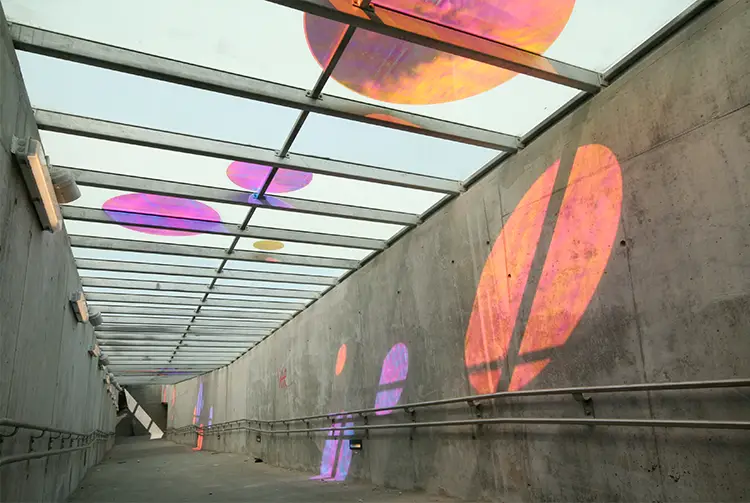
Reflections #14:20 PM, 2006.
Light installation of dichroic film, illuminated by changing sun, tram and daylight. Variable sizes.
Photo: Viel Bjerkeset Andersen, curtesy of the Ring Line, Oslo municipality.
Time-Based Encounters: Surface, Scale, and the Subtle Politics of Attention
Projects such as Reflections at Sinsen Metro Station and Solaris at Bryne Railway Station continue Andersen’s inquiry into how perception, light, and material structure affect shared experience. In Reflections, dichroic film applied to glass surfaces translates daylight, the movement of the sun throughout the day and tram lighting into a play of shifting color that unfolds across the daily and seasonal rhythms of transit. Here, Andersen creates what might be called an ambient commons: a space in which co-perception replaces co-action, where passengers encounter a subtle transformation of space not through deliberate participation but through shared exposure. This ambient register aligns with Jacques Rancière’s notion of the redistribution of the sensible, whereby the field of perception is reorganized and, in doing so, alters the possibilities of collective life.
In Swirl, a polycarbonate pattern spirals across a pedestrian bridge, engaging not only walkers but also motorists and viewers at adjacent gas stations. This work serves as a kinesthetic diagram that unifies disparate forms of movement into a coherent visual rhythm. Rather than offering a focal point, Swirl disperses attention across a gradient of speeds and scales, creating an ephemeral unity that persists across variation. The material strategy—durable, weather-resistant panels embedded with subtle LED-lighting along the top of the panels—underscores Andersen’s commitment to sustainability and longevity. The success of these works does not lie in their visibility alone but in how they integrate into the life of a place, transforming it without dominating it.
More intimate installations, such as Stopover at Refstad School or Yellow Enigma at Risenga Square, extend Andersen’s ethics of relation into the micro-geographies of play and rest. Stopover is a concrete carpet embedded with colored industrial byproducts, forming a tactile landing zone for children’s bodies. Its lack of prescriptive form invites improvisation, balance, and gathering. Yellow Enigma, on the other hand, includes a movable inner component that encourages negotiation and interaction. These moments of minor conflict—who turns the circle, who waits, who watches—enact Bishop’s call for relational antagonism, offering scenarios in which public art becomes a site of low-stakes struggle and co-authored meaning. Andersen’s art thrives in these ambiguous registers, where invitation is not command and interaction remains open-ended.
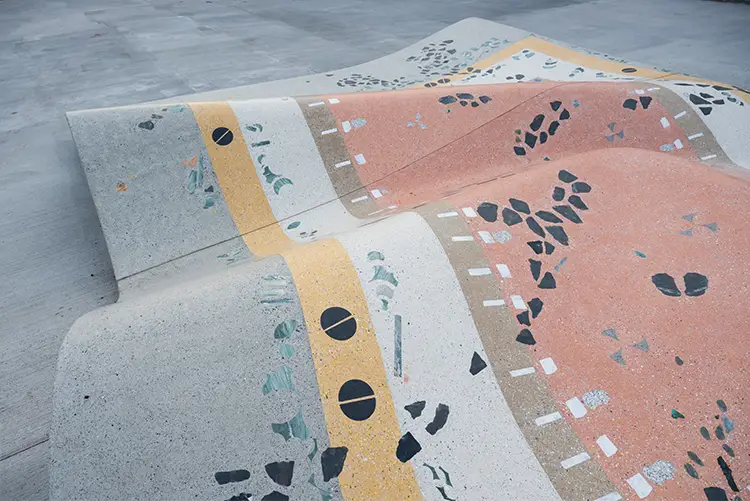
Stopover, 2024.
Carpet of colored concrete with embedded industrial byproducts, honed surface. 500 x 750 x 60 cm.
Photo: Finn Ståle Felberg, curtesy of the City of Oslo Art Collection.
Viel Bjerkeset Andersen: Ethics of Duration and Material Translation
Andersen’s works must be understood not only as isolated projects but as components within a larger theory of infrastructural aesthetics, where material, time, and institutional networks co-produce meaning. This is particularly evident in projects such as Strata, a sculptural landscape at a vocational school and dental clinic in Grimstad. Cast in concrete and designed to accommodate both moss and movement, the installation layers geological metaphor with social function. The stepped design offers seating, gathering, and informal interaction across multiple user groups. The work’s title and form reference stratification in both natural and human terms, gesturing toward a politics of encounter that unfolds through material affordance rather than didactic narrative.
In Solaris, a suspended sculpture of assembled fluorescent acrylic discs at Bryne Station, Andersen compresses this expansive approach into a singular form. Suspended overhead, the piece captures daylight and artificial light alike, reframing the transit hub as a place of contemplation and vertical orientation. It functions simultaneously as sculpture, skylight, and signal. The work avoids the cliches of urban branding while remaining legible as a civic marker. Its maintenance requirements are minimal, its energy demands nearly nonexistent. In this regard, Solaris exemplifies Andersen’s ethics of economy: doing more with less, allowing form and light to generate presence without overwhelming space. This orientation is not merely aesthetic but ethical, reflecting a concern for ecological limits and material humility.
What links Andersen’s diverse projects is not style but structure. Her work is always already in relation: to commissioners, to users, to institutional frameworks, and to the ecological systems within which they operate. She is not a solitary author but a collaborator, often negotiating with engineers, architects, and bureaucrats to shape works that can endure and adapt. Her light interventions are calibrated for darkness as much as visibility, her forms designed to resist wear as much as invite use. The politics of her work lie not in overt statements but in the subtle redistribution of attention, care, and access. Through careful calibration of material, perception, and institutional commitment, Andersen proposes a model of public art that is as infrastructural as it is relational, one that endures not through monumentality but through embeddedness, responsiveness, and co-presence.
